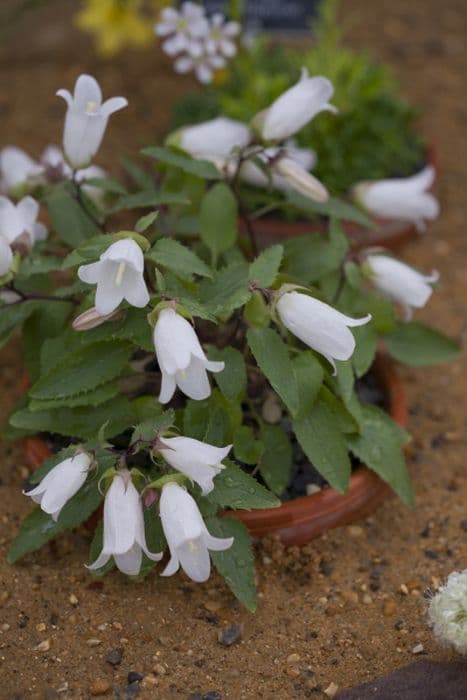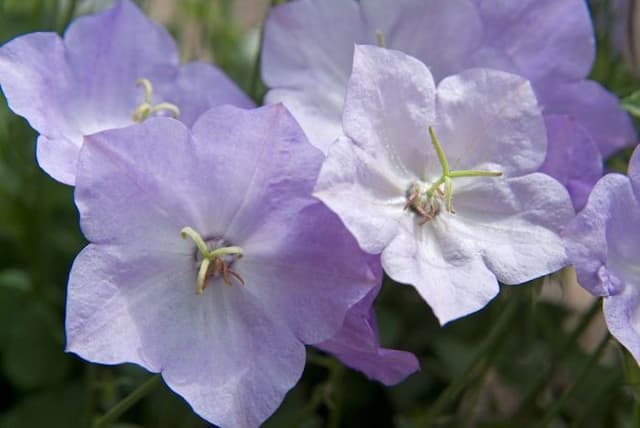Clustered Bellflower Campanula glomerata 'Joan Elliott'

ABOUT
The Campanula glomerata 'Joan Elliott', commonly known as Clustered Bellflower, is a perennial plant that is known for its striking appearance. It has a lush foliage of green leaves, which are often toothed and can be either heart-shaped or lance-shaped, providing a textured backdrop to its floral display. The leaves sometimes can have fine hairs, giving them a slightly rough texture to the touch. The Clustered Bellflower 'Joan Elliott' produces a profusion of alluring flowers that typically bloom in the late spring to summer period. These flowers are the star attraction of the plant, arranged tightly at the top of the stem in rounded clusters, hence the name "clustered." The blooms boast an intense violet-blue hue that can act as a vivid splash of color in any garden setting. Each individual flower is bell-shaped, a signature characteristic of the Campanula family, and they possess a certain grace with their flared ends and neatly folded petals that curve back just slightly. The inside of the bells may reveal subtle striations of a paler color, which can draw in the eyes and further accentuate the depth of the flower's design. The overall effect of Campanula glomerata 'Joan Elliott' is one of rustic charm and bright, vibrant color. When in full bloom, the plant is a magnet for pollinators like bees and butterflies, which adds to the dynamic feel of the garden's ecosystem where it's planted. The clustered formation of the flowers makes this plant especially attractive as it can provide a focal point in whimsical cottage gardens or more formal beddings alike due to its organized, yet vivid, display of blooms.
About this plant
 Names
NamesFamily
Campanulaceae
Synonyms
Clustered Bellflower, Dane's Blood
Common names
Campanula glomerata 'Joan Elliott'.
 Toxicity
ToxicityTo humans
Clustered bellflower (Campanula glomerata 'Joan Elliott') is generally considered non-toxic to humans. There are no known toxic effects from ingesting any part of this plant. However, it's always wise to exercise caution and avoid eating ornamental plants as a general rule. If large amounts were consumed, it might cause stomach upset due to its fibrous nature, but this is not specific toxicity.
To pets
Clustered bellflower (Campanula glomerata 'Joan Elliott') is also generally considered non-toxic to pets. It is not listed as toxic to dogs, cats, or other household pets. There should not be any severe symptoms of poisoning following the ingestion of this plant. However, as with any non-food plant, ingestion might cause mild gastrointestinal upset, such as vomiting or diarrhea, in some pets due to the plant's fiber content or a pet's sensitivity.
 Characteristics
CharacteristicsLife cycle
Perennials
Foliage type
Deciduous
Color of leaves
Green
Flower color
Purple
Height
1-2 feet (30-60 cm)
Spread
1-2 feet (30-60 cm)
Plant type
Herb
Hardiness zones
3-8
Native area
Europe
Benefits
 General Benefits
General Benefits- Attracts Pollinators: Provides nectar for bees, butterflies, and other beneficial insects, enhancing pollination in the garden.
- Aesthetic Appeal: Adds visual interest with its vivid blue-purple flowers, enhancing the beauty of garden landscapes.
- Easy to Grow: Known for being hardy and low maintenance, making it suitable for gardeners of all skill levels.
- Drought Tolerance: Once established, it has good tolerance to dry conditions, reducing the need for frequent watering.
- Perennial Growth: Comes back year after year, providing long-term value and reducing the need to replant annually.
- Cottage Garden Plant: Fits well in traditional cottage garden schemes with its quaint and charming appearance.
- Wildlife Friendly: Offers a habitat and food source for wildlife, contributing to biodiversity in the garden.
- Border Planting: Suitable for use in borders due to its clumping growth habit and attractive flower clusters.
- Ground Coverage: Can be used as ground cover to minimize weed growth and soil erosion in the garden.
- Rapid Growth: Grows quickly to fill in spaces, which is beneficial for new or renovating gardens needing fast coverage.
 Medical Properties
Medical PropertiesThis plant is not used for medical purposes.
 Air-purifying Qualities
Air-purifying QualitiesThis plant is not specifically known for air purifying qualities.
 Other Uses
Other Uses- Clustered Bellflower can be used to create natural dyes for fabrics, giving a range of colors based on the mordant used.
- Its dried seed pods can add an interesting texture to potpourri blends.
- Artists can use the pressed flowers of the Clustered Bellflower in botanical paper-making or to embellish handmade paper.
- Clustered Bellflower can serve as a muse for photographers and painters because of its vibrant color and attractive shape.
- The plant's sturdy stems make it a good candidate for structural support in mixed floral art projects or installations.
- Gardeners sometimes use Clustered Bellflower in companion planting to attract pollinators, aiding the growth of vegetable crops.
- Clustered Bellflower can be used in water-conserving gardens or xeriscaping because of its drought-resistant qualities.
- Its flowers can be floated in water bowls as a decorative element for outdoor summer parties.
- You can use the silhouettes of Clustered Bellflower's flowers in designing patterns for textiles or wallpaper.
- Children can use the bell-shaped flowers in nature-inspired crafts, like creating fairy garden decorations.
Interesting Facts
 Feng Shui
Feng ShuiThe plant Clustered Bellflower is not used in Feng Shui practice.
 Zodiac Sign Compitability
Zodiac Sign CompitabilityThe plant Clustered Bellflower is not used in astrology practice.
 Plant Symbolism
Plant Symbolism- Enduring love: Campanula, commonly known as "Clustered Bellflower," often symbolizes unwavering affection and devotion due to its perennial nature, blooming year after year.
- Gratitude: The bell-shaped flowers are reminiscent of someone bowing in thanks, making them a symbol of appreciation and gratitude.
- Constancy: Similar to 'enduring love', the Clustered Bellflower can also represent steadfastness and reliability in relationships, due to its reliable blooming each season.
- Attractiveness: With its vibrant blue-violet flowers, the Clustered Bellflower is symbolic of beauty and attractiveness, often used to indicate someone's enchanting presence.
 Water
WaterClustered Bellflower (Campanula glomerata 'Joan Elliott') should be watered deeply when the top inch of soil feels dry to the touch, typically once or twice a week during active growing seasons. In hot, dry conditions, more frequent watering may be necessary. Provide enough water to saturate the root zone, which is usually around 1 gallon for a medium-sized plant. During the dormant period in winter, water sparingly, just enough to keep the soil from drying out completely. Always avoid overwatering as it can lead to root rot; well-drained soil is essential to prevent this.
 Light
LightThe Clustered Bellflower thrives in full sun to partial shade conditions. Ideally, it should be placed in a location where it receives at least 6 hours of sunlight daily. However, in hotter climates, some afternoon shade can be beneficial to prevent scorching of the leaves.
 Temperature
TemperatureClustered Bellflower prefers moderate temperatures and can handle a range between 40°F to 75°F. It can tolerate occasional dips below freezing, but prolonged exposure to temperatures below 20°F may be harmful. Ideally, maintain an environment where the plant is kept in its preferred temperature range for optimal growth.
 Pruning
PruningPrune the Clustered Bellflower after it has finished blooming, typically in late summer or fall, to tidy up the plant and promote healthy growth for the following season. Cut back spent flower stems and remove any dead or damaged foliage. This not only improves the plant's appearance but also helps to prevent disease. Occasional deadheading can be done during the blooming period to encourage more flowers.
 Cleaning
CleaningAs needed
 Soil
SoilClustered Bellflower prefers well-draining soil with good fertility, a mix of loam, peat, perlite, and compost works well. The ideal pH range for Clustered Bellflower is between 6.0 and 7.5.
 Repotting
RepottingClustered Bellflower, being a perennial, typically doesn't require frequent repotting and can be evaluated every 2-3 years or when you see roots coming out of the drainage holes.
 Humidity & Misting
Humidity & MistingClustered Bellflower thrives in average humidity levels but is adaptable to a variety of conditions and does not require special humidity considerations.
 Suitable locations
Suitable locationsIndoor
Use bright indirect light and well-draining soil for Clustered Bellflower.
Outdoor
Plant in well-draining soil with full sun to partial shade.
Hardiness zone
3-8 USDA
 Life cycle
Life cycleClustered Bellflower 'Joan Elliott' begins its life as a seed that germinates in early spring, typically after experiencing a cold period that breaks its dormancy. Once the seedling emerges, it develops into a rosette of basal leaves and establishes a root system. As the plant matures, it sends up flowering stems in late spring to early summer, which bear dense clusters of violet-blue, bell-shaped flowers. After pollination, typically by bees or other insects, the flowers develop into fruit capsules containing small seeds. As the growing season ends, the plant may die back to the ground in colder climates, surviving the winter as a root system or as a basal rosette in milder areas. The plant is perennial and will re-emerge from its roots the following spring, continuing its life cycle.
 Propogation
PropogationPropogation time
Spring to Summer
Propogation: Clustered Bellflower 'Joan Elliott' can be propagated by division, ideally during the fall or very early spring just as the plant starts showing growth. The most popular method is division, where gardeners carefully dig up the plant and separate the root clump into smaller sections, making sure each section has a piece of root and a few shoots. These sections are then replanted in well-prepared soil, spaced about 12 to 15 inches (30 to 38 centimeters) apart to allow for proper growth. Watering the new plants thoroughly after planting ensures proper establishment. This method is favoured for its simplicity and effectiveness in producing new, vigorous plants that will typically flower in the following growing season.









